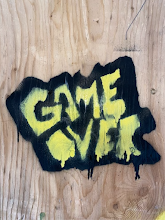Intersection + Intermedia
This posting, as well as the previous one, are the transcripts from a panel discussion I participated in as part of the Hybrid Book Conference in Philadelphia PA on June 6th, also participating were: Marlene MacCallum, David Morrish, William Snyder, Andrew Sallee and Tate Shaw. Michelle Wilson moderated the panel.
This statico-dynamic was projected during this talk.
This posting, as well as the previous one, are the transcripts from a panel discussion I participated in as part of the Hybrid Book Conference in Philadelphia PA on June 6th, also participating were: Marlene MacCallum, David Morrish, William Snyder, Andrew Sallee and Tate Shaw. Michelle Wilson moderated the panel.
This statico-dynamic was projected during this talk.
PART II (inter/media)
The sillis project investigates the effect of digital processes on the production of book works. Three artists set out to produce experimental works exploring process and concept. Each with different levels of experience with computers, from basic to advanced. Works are made independently but some striking similarities are emerging.
The effects of the digital on the production of work are fairly obvious, they aid in the development of pictorial explorations, render feasible operations that would be so intricate as to be counter-productive, they allow the artist to visit a wide range of possibilities in a short span of time. Concentration can be centred on more conceptual factors.
What is less obvious and deserving of attention is the affect of digital processes on the production of work. Are thematic or conceptual choices within the originating thought processes influenced by digital technologies? Does digital technology represent a different sphere of intersection?
In our group (sillis), we all work with lens-based technologies; we understand that photographs fluctuate between the textual and the visual. They are the space of transformation and translation of information. Sequencing acts to shift paradigms. Photography’s hybrid nature is a given, it is a consequence of operational parameters. It is possibility. Our actions reveal the potential. Photography’s élan vital (vital impetus) is enacted through the artist rather than the technology. These distinctions are important when trying to untangle the folding and unfolding surfaces of the hybrid/digital and the integrated/virtual.
Let us think about the articulation of what we call “the digital”. Does it actually exist as such, or is it simply a framework on which to hang parts of a process, or a bit of both? In “Parables for the Virtual”, Brian Massumi explores how the digital, as an independent operational object, separate from the analogue, is improbable:
“…the paths of their (digital + analogue) co-operation- transformative integration, translation, and relay-are themselves analogue operations. There is always an excess of the analogue over the digital, because it perceptually fringes, synasthetically dopplers, umbilically backgrounds, and insensibly recedes to a virtual centre immanent at every point along the path-all in the same contortionist motion. It is most twisted. The analogue and the digital must be thought together, asymmetrically. Because the analogue is always a fold ahead." (MASSUMI p.143)
For all intents and purposes, the digital only exists in the machine; any synasthetic representation of it will be analogue. Given the opposition drawn earlier between the hybrid and the virtual, I would like to propose a parallel opposition between the digital and intersection. Digital coding is a medium of possibility, like the hybrid it is a passive articulation of the possible and cannot express potential.
According to Bergson, the virtual is the space of difference, it qualifies and quantifies it and is a representation of its potential nuances, the key word being “potential” rather than “possible”. And it is an active process. We can then equate intersection with virtuality through their intentional expressions of potential, and hybrid with digital through their more passive expression of possibility. The possible is an engine of potentiality, but not a creative force on its own.
Virtuality is not exclusive to the digital, quoting Massumi again:
“If all emergent form brings its fringe of virtuality with it, then no particular medium of expression has monopoly over the virtual. Every medium, however “low” technologically, really produces its own virtuality (yes, even painting). “Digital Art” is in no way synonymous with “virtual reality”. What matters is the “how” of the expression, not the “what” of the medium, and especially not the simple abstractness of the elements that the medium allows to be combined." (MASSUMI p.175)
In a culture dominated by text and image, the Internet being a representation of this; a properly articulated conception of inter-mediation is needed. Digital and hybrid forms offer the possibilities needed to make objects; but to give forms potential they must be made virtual and inter-mediated. The difference between the hybrid/digital and the intersecting/virtual is the difference between possibility and potential.
Massumi, Brian, Parables for the Virtual, Duke University Press, Durham & London, 2002

No comments:
Post a Comment